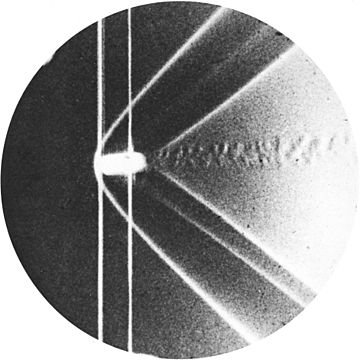Ernst Mach facts for kids
Quick facts for kids
Ernst Mach
|
|
|---|---|

Ernst Mach (1838–1916)
|
|
| Born |
Ernst Waldfried Josef Wenzel Mach
18 February 1838 |
| Died | 19 February 1916 (aged 78) |
| Nationality | Austrian |
| Citizenship | Austrian |
| Alma mater | University of Vienna |
| Known for | Mach number Mach's principle Shock waves Mach waves Mach reflection effects Mach band Criticism of Isaac Newton's bucket argument Mach diamonds Empirio-criticism Relationism |
| Scientific career | |
| Fields | Physicist |
| Institutions | University of Graz Charles University (Prague) University of Vienna |
| Doctoral advisor | Andreas von Ettingshausen |
| Doctoral students | Heinrich Gomperz Ottokar Tumlirz |
| Other notable students | Andrija Mohorovičić |
| Influences | Andreas von Ettingshausen Gustav Fechner Carl Ludwig |
| Influenced | Vienna Circle Russian Machism Ludwig Boltzmann Albert Einstein Wolfgang Pauli William James Wilhelm Kienzl Pierre Duhem |
| Signature | |
| Notes | |
|
He was the godfather of Wolfgang Pauli. The Mach–Zehnder interferometer is named after his son Ludwig Mach, who was also a physicist.
|
|
Ernst Waldfried Josef Wenzel Mach (born February 18, 1838 – died February 19, 1916) was an Austrian physicist and philosopher. He is famous for his work on shock waves. The "Mach number" is named after him. It describes how fast something is moving compared to the speed of sound.
As a philosopher, Mach's ideas influenced many thinkers. His thoughts on space and time helped shape Albert Einstein's theory of relativity. Later in life, Mach retired from his university work due to health. He moved to his son's home near Munich, where he continued writing until his death in 1916.
Contents
Early Life and Education
Ernst Mach was born in Chrlice, which is now part of Brno in the Czech Republic. His father was a tutor for a noble family. His grandfather was a master builder, and his work may have influenced Ernst Mach's later ideas.
Mach was taught at home by his parents until he was 14. He then went to a school called a Gymnasium for three years. In 1855, he began studying at the University of Vienna. He focused on physics and also studied medical physiology for a short time.
In 1860, Mach earned his doctorate in physics. His early research looked at the Doppler effect. This effect explains how sound or light waves change as their source moves.
A Professor's Journey
In 1864, Mach became a Professor of Mathematics at the University of Graz. He later became a Professor of Physics there in 1866. During this time, he continued his work on how people sense things.
In 1867, Mach moved to Prague. He became a Professor of Experimental Physics at Charles University. He stayed there for 28 years before returning to Vienna.
Mach's Contributions to Physics
Mach's most important work in physics involved studying and photographing shock waves. He showed how objects moving faster than the speed of sound create a compressed air wave in front of them. This is like the "sonic boom" you hear from a supersonic jet.
Mach and physicist Peter Salcher published their findings in 1887. They correctly described the sound effects of supersonic motion. They also proved the existence of a cone-shaped shock wave. This wave forms with the moving object at its tip.
The ratio of an object's speed to the speed of sound is now called the Mach number. It is very important for understanding how fluids move at high speeds. This includes studies in aerodynamics (how air moves around objects) and hydrodynamics (how liquids move).
Mach's Principle
One of Mach's most famous ideas is "Mach's principle." This idea is about where inertia comes from. Inertia is the tendency of an object to resist changes in its motion.
Mach never wrote down this principle himself. But it was described by others using his words. A famous example is: "When the subway jerks, it's the fixed stars that throw you down." This means that inertia might be related to all the other matter in the universe.
Mach believed that physics should only be based on things we can directly observe. He also thought that ideas like "absolute space and time" were not needed. Instead, he focused on relative motion. He suggested that effects like inertia come from the way matter is spread out in the universe.
Albert Einstein was very influenced by Mach's principle. Einstein even said that Mach was a "precursor" to his own general relativity theory. However, Mach himself did not fully accept Einstein's theory before he died.
Eponyms
Many things are named after Ernst Mach to honor his work:
- Mach, a crater on the Moon
- Mach bands, an optical illusion
- 3949 Mach, an asteroid
- Mach number, the unit for speed relative to the speed of sound
See also
 In Spanish: Ernst Mach para niños
In Spanish: Ernst Mach para niños




